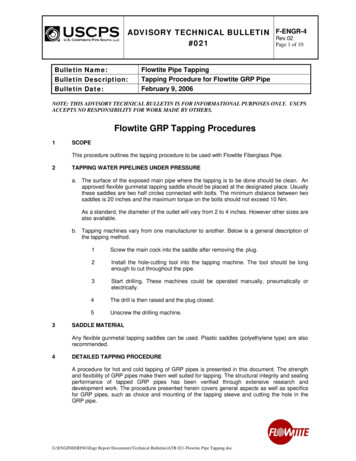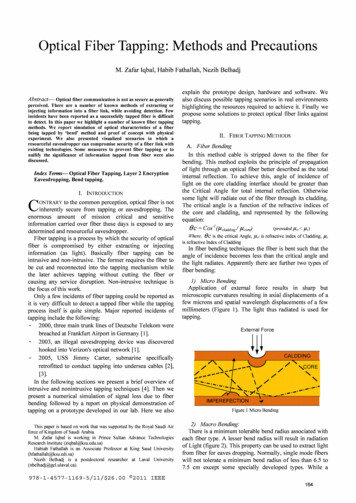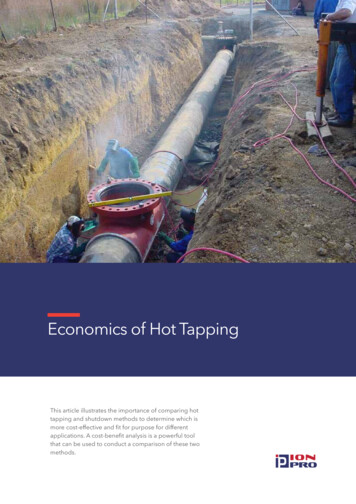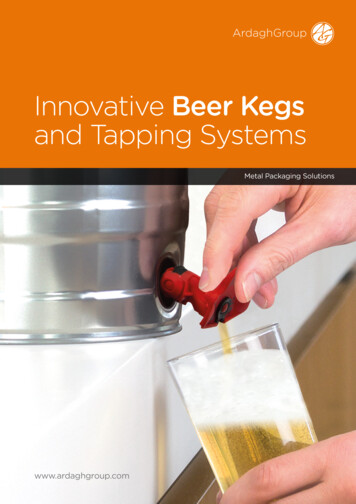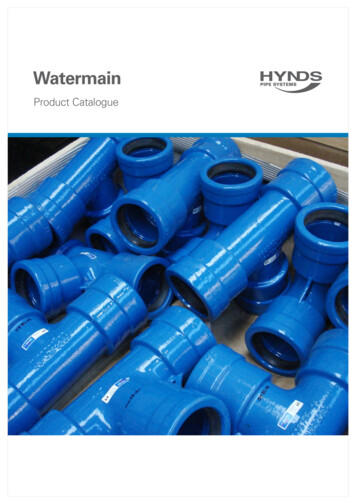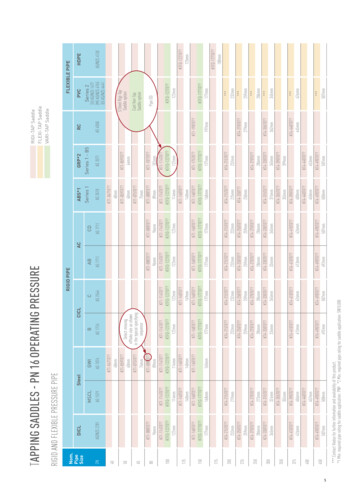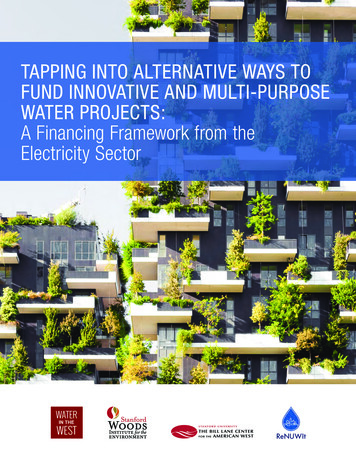
Transcription
TAPPING INTO ALTERNATIVE WAYS TOFUND INNOVATIVE AND MULTI-PURPOSEWATER PROJECTS:A Financing Framework from theElectricity Sector
February 2016AuthorsKim Quesnel; Newsha K. Ajami, Ph.D.*; and Noemi WyssAcknowledgmentsThis work was made possible by support from the National Science Foundation (grant 28139880-50542-C), the NationalScience Foundation Engineering Research Center for Reinventing the Nation’s Urban Water Infrastructure (ReNUWIt)(award EEC-1028968), and Stanford University.We acknowledge Natalie Shell for research assistance, and David Smith, Matthew Mitchell, David Hayes, and DianGrueneich for invaluable feedback.Recommended CitationQuesnel, K., Ajami, N.K., & Wyss, N. (2016). Tapping Into Alternative Ways to Fund Innovation and Multi-purpose WaterProjects: A Financing Framework from the Electricity Sector. Stanford Woods Institute for the Environment.ContactWater in the WestStanford UniversityJerry Yang and Akiko Yamazaki (Y2E2) Building473 Via Ortega, MC 4205Stanford, CA 94305waterinthewest@stanford.eduAbout Water in the WestWater in the West is a partnership of the faculty, staff and students of the Stanford Woods Institute for the Environmentand the Bill Lane Center for the American West. The mission of Water in the West is to design, articulate, and advancesustainable water management for the people and environment of the American West. Linking ideas to action, weaccomplish our mission by engaging in cutting-edge research, creative problem solving, active collaboration with decisionmakers and opinion leaders, effective public communications and hands-on education of students. To learn more visit:waterinthewest.stanford.edu.*Corresponding author newsha@stanford.edu
TABLE OF CONTENTSExecutive Summary. 11.Introduction . 32.Rethinking America’s Water Infrastructure . 52.1 The Need for Water Innovation: Integrating Distributed Water Solutions. 52.1.1 Green Infrastructure. 52.1.2 Demand Side Management (DSM). 62.1.3 Decentralized Wastewater Treatment and Greywater Systems. 72.2 Barriers to Adaption of Distributed Water Projects. 72.3 Comparing Water and Energy. 82.4 The Evolution of the Electricity Sector: Distributed Energy Solutions. 92.4.1 Renewable Energy. 102.4.2 Demand Side Management (DSM) . 10Financing and Governance Framework. 1133.1 Methodology and Framework. 113.2 Catalyzing Change. 123.2.1 Direct Regulations. 123.2.2 Market Forces and Economic Incentives . 133.2.3 Price Structuring and Revenue Decoupling. 153.3 Establishing Funding Sources. 153.3.1 Public Investment . 153.3.2 Private Capital. 163.4 Using Resource Pathways. 183.4.1 Government Grants and Loans . 183.4.2 Rebates. 193.4.3 Tax Credits. 193.4.4 On-Bill Initiatives . 203.5 Creating Innovative Governance Structures. 213.5.1 Project and Financial Aggregation. 213.5.2 Alternative Investment Structures. 223.5.3 End-to-End Service Companies . 233.5.4 Lease and Purchase Power Agreements (PPA) Programs. 233.5.5 Net Metering . 244Case Studies in the Water Sector. 254.1 Stormwater Management in Philadelphia, Pennsylvania . 254.2 LID Trading in Cincinnati, Ohio. 264.3 Water Reuse in San Francisco, California. 265Findings. 285.1 Policies and Economic Forces Drive Change. 285.2 Cost Sharing is an Enabler. 285.3 Look Beyond Traditional Funding Sources. 295.4 Utilize a Diverse Financing Portfolio . 305.5 Everyone Benefits from Collaboration . 306Conclusion. 317References. 32
LIST OF FIGURESFigure 1.Figure 2.Figure 3:Figure 4:Figure 5:Figure 6:Figure 7:Figure 8:Figure 9:Community Water Systems in the United States: System Size by Population Served. 3Types of Green Infrastructure and Benefits. 6Annual Energy Star Greenhouse Gas Reductions Since 2000. 10Financing and Governance Framework. 12Renewables Portfolio Standards (RPS) capacity installed in California since 2003. 13Total Installed PV Prices, Global Average System Price. 14Reasons that Customers Purchase Clean Energy Devices and Appliances. 14U.S. Private Investment in Clean Energy. 17Electricity Pricing and Conservation in California. 28LIST OF TABLESTable 1:Table 2:Table 3:Table 4:Table 5:Traditional vs. Distributed Water Management Strategies. 5Comparison of Water and Electricity. 9On-Bill Initiatives. 20Financing Framework in the Water Sector. 25Water Reuse Incentives. 27
ABOUT THE AUTHORSKim Quesnel is a Ph.D. student at Stanford University studying civil and environmental engineering. Her research concentrateson water policy, financing, and conservation through Stanford University’s Water in the West and the NSF’s Engineering ResearchCenter for Reinventing the Nation’s Urban Water Infrastructure (ReNUWIt). Prior to coming to Stanford, Quesnel worked as a civilengineer in Denver, Colorado in the field of environmental remediation, responsible for both technical design work and projectmanagement. She has also worked on a wide range of water-related research projects including the laboratory investigation oftsunami wave breaking behavior, the assessment and design of water filtration in rural Thailand, and the study of glacier hydrologythrough field research in Alaska. Quesnel received a B.S. in civil engineering from California Polytechnic State University, San LuisObispo and an M.S. in civil and environmental engineering, environmental fluid mechanics and hydrology from Stanford University.Newsha K. Ajami is the director of Urban Water Policy with Water in the West and the NSF-ReNUWIt initiative. She is a hydrologistspecializing in sustainable water resource management, water policy, the water-energy-food nexus, and advancing uncertaintyassessment techniques impacting hydrological predictions. Her research throughout the years has been interdisciplinary and impactdriven, focusing on the improvement of the science-policy stakeholder interface by incorporating social and economic measures andrelevant and effective communication. Dr. Ajami is also a gubernatorial appointee to the Bay Area Regional Water Quality ControlBoard. Before joining Stanford, she worked as a senior research associate at the Pacific Institute from 2011 to 2013, and servedas a Science and Technology fellow at the California State Senate’s Natural Resources and Water Committee where she worked onvarious water and energy related legislation. She was also a postdoctoral researcher with the Berkeley Water Center, University ofCalifornia, Berkeley. She has published many highly cited peer-reviewed papers in prominent journals, coauthored two books, andcontributed opinion pieces to the New York Times and the Sacramento Bee. She was the recipient of the 2005 National ScienceFoundation award for the American Meteorological Society’s Science and Policy Colloquium and ICSC-World Laboratory HydrologicScience and Water Resources Fellowship from 2000 to 2003. Ajami received her Ph.D. in civil and environmental engineering fromthe University of California, Irvine; an M.S. in hydrology and water resources from the University of Arizona; and a B.S. in civil andenvironmental engineering from Tehran Polytechnic.Noemi C. Wyss is an M.S. student at the University of California, Irvine in the urban and regional planning program. Prior toattending graduate school, she was a research intern with the Water in the West and ReNUWIt, working on a number of urbanwater projects. Previously, she also completed an internship with the World Business Council for Sustainable Development inGeneva, Switzerland and the Swiss Foundation for Federal Cooperation. Her research interests include urban water policy relatedto conservation, changing public opinion on water issues, and discovering new ways to finance innovative water systems. Wyssreceived her B.A. in international relations and environmental analysis and policy from Boston University.WATER IN THE WESTTapping into Alternative Ways to Fund Innovative and Multi-Purpose Water Projectsiii
ACRONYMSABSAsset-Backed SecuritiesNEMNet Energy MeteringACEEEAmerican Council for an Energy Efficient EconomyOBROn-Bill RepaymentAWWAAmerican Water Works AssociationOBFOn-Bill FinancingCECCalifornia Energy CommissionPACEProperty Assessed Clean EnergyCPUCCalifornia Public Utilities CommissionPOUPublicly-Owned UtilityDSMDemand Side ManagementPPAPurchase Power AgreementDOEU.S. Department of EnergyPWDPhiladelphia Water DepartmentDSIREDatabase of State Incentives for Renewablesand EfficiencyREITReal Estate Investment TrustRES-BCTECAAEnergy Conservation Assistance ActRenewable Energy Self-Generation –Bill Credit TransferEECBGEnergy Efficiency and Conservation Block GrantRPSRenewables Portfolio StandardEIBEnvironmental Impact BondSBSenate BillEPAU.S. Environmental Protection AgencySEIASolar Energy Industries AssociationESCOEnergy Service CompanySFPUCSan Francisco Public Utilities CommissionGHGGreenhouse GasSMIPStormwater Management Incentives ProgramIOUInvestor-Owned UtilityVNMVirtual Net MeteringITCInvestment Tax CreditWEFWater Environment FederationLIDLow Impact DevelopmentWERFWater Environment Research FoundationMLPMaster Limited PartnershipWIFIAWater Infrastructure Finance and Innovation ActNAESCONational Association of EnergyService CompaniesWATER IN THE WESTTapping into Alternative Ways to Fund Innovative and Multi-Purpose Water Projectsiv
EXECUTIVE SUMMARYOver the past century, the United States has developed one of the largest water sectors in the world. Our water and wastewaternetwork is a widespread, centralized infrastructure system designed to improve water reliability, manage stormwater, and controlwastewater effluent. This network of dams, aqueducts, levees, treatment facilities, and millions of miles of pipelines has enhancedour nation’s social, economic, and environmental well-being by ensuring dependable access to clean water. Federal and stategovernments have played a vital role in making this possible through direct investment in the form of grants, subsidies, and taxexemptions for municipal bonds.Yet, our sophisticated water system is in need of renewed investment due to population growth, urbanization, climate changeimpacts, environmental degradation, aging infrastructure, and ever-increasing operation and maintenance costs. Tackling thesemodern challenges calls for new thinking and innovative, multi-purpose infrastructure solutions. There is an opportunity toreimagine conventional water management in the U.S. by taking a more holistic, integrated, and contemporary approach. However,the financial landscape in the water and wastewater sector is changing, and securing funding for new projects can be difficult.Traditional federal and state government funds are limited, and local utilities and municipalities are often too cash-strapped to meetexisting operations and maintenance obligations, let alone finance new projects. Additionally, private investors sometimes shy awayfrom certain water projects because of their potentially high risks due to limited track records and slow or small rates of return.This absence of available and appropriate funding resources has created a financial barrier and played a key role in slowing thewidespread integration of new technological solutions into America’s water infrastructure. One of these solutions is the incorporationof innovative and multi-purpose water projects, such as distributed solutions that are designed to manage water more locallyand closely mimicking the natural hydrologic cycle. Examples of these small- to medium-scale innovative projects include greeninfrastructure designed to manage stormwater, demand-side management (DSM) measures that protect potable source water fromwaste, and decentralized wastewater treatment systems. Incorporating these solutions has the potential to offer increased flexibilityin responding to a changing climate and meeting future water quality and quantity needs.The objective of this paper is to identify and explore innovative funding and governance mechanisms that can be used to support theintegration of new distributed water infrastructure, practices, and technologies. To accomplish this, we looked outside of the watersector to explore financing tools and techniques that have been used by the electricity sector to implement distributed solutions.Distributed energy resources encompass a wide range of technologies and practices at various scales. Here, we investigate two:renewable generation and electricity DSM practices.In this research, we first reviewed case studies of successfully implemented distributed energy projects to determine what toolshave been used to develop, finance, and implement these solutions. We also examined the challenges stakeholders faced duringimplementation, and how they overcame the series of risks that preclude innovation. We then used our findings to developa financing framework that could help the water sector transition to include more distributed solutions. We propose that thisframework has four central elements critical for project financing: catalyzing change, establishing funding sources, using resourcepathways, and creating innovative governance structures. We evaluated many mechanisms within each element. Those discussed inthis report are most appropriate for the water sector.WATER IN THE WESTTapping into Alternative Ways to Fund Innovative and Multi-Purpose Water Projects1
FINANCING FRAMEWORKELEMENTSCatalyzing Changethrough external forcesEstablishing FundingSources that can bepublic or privateUsing ResourcePathways to facilitatethe flow of financialand technical resourcesamong stakeholdersCreating InnovativeGovernance Structuresthat enable projectimplementationEXAMPLE MECHANISMSRegulations, marketforces, decoupledpricing structuresBonds, end-user fees,venture capitalGrants and loans,rebates, tax creditsAggregation, alternativeinvestment structures,Energy ServiceCompanies (ESCOs)The water sector can learn many lessons from distributed project implementation in the electricity sector. Through this investigation,we determined that the water sector should utilize tools that promote cost sharing with end users, look beyond traditional waterspecific funding resources, develop diverse financing portfolios, and encourage collaboration among all stakeholders. By evaluatinghow the electricity sector has financed innovative distributed energy solutions, we elucidate ways that the water sector could fundinnovative and multi-purpose projects in the future. Many of these financing tools and governance structures could be used notonly for distributed solutions, but by the water sector as a whole to help revamp our nation’s urban water systems. All infrastructuretransitions require extensive capital, and the water sector must secure adequate funding if it is to move into a more sustainable andresilient future.WATER IN THE WESTTapping into Alternative Ways to Fund Innovative and Multi-Purpose Water Projects2
1. INTRODUCTIONThroughout the 20th century, the United States has invested heavily to create one of the largest water infrastructure systems inthe world (Hering et al., 2013). This network of dams, aqueducts, levees, treatment facilities, and millions of miles of pipelines hasenhanced our nation’s social, economic, and environmental well-being by improving water supply reliability, preventing flooding, andmanaging wastewater effluent (The Johnson Foundation, 2014). Federal and state governments have played a vital role in makingthis possible through direct investment in the form of grants, subsidies, and tax exemptions for municipal bonds (Hanak et al.,2014).Nevertheless, modern challenges including environmental degradation, a changing climate, urbanization, aging infrastructure, andever increasing operation and maintenance costs are testing the reliability and resiliency of our nation’s water system (Hering etal., 2013). The disjointed and antiquated governance structures that currently overlay our centralized network are too rigid andpolitically complex to handle these issues (Ajami et al., 2014). Our water system is extremely fragmented as thousands of smallutilities serve the majority of the population (Figure 1), many different government agencies are responsible for oversight, anddifferent water types such as stormwater, drinking water, and wastewater are managed separately (Mukheibir et al., 2014).Figure 1. Community Water Systems in the United States: System Size by Population Served60%50%% of systems% of pop40%30%20%10%0%500 or less501-3,3003,301-10,00010,001-100,000 100,000Population ServedSource: Source: U.S. EPA, 2009To modernize our systems, we must take a holistic, integrated, and innovative approach to water resource management. Significantcapital is required for this reinvention, however, and the financial landscape in the water sector is laden with problems that makefinancing new projects difficult (Hanak et al., 2014). Consequently, the water sector has been slow to evolve and to incorporatenew technological solutions into existing infrastructure systems (Kiparsky et al., 2013). One of these solutions is the integration ofinnovative and multi-purpose distributed water projects. Distributed water solutions include infrastructure, systems, technologies,and practices that manage water more locally than traditional infrastructure and more closely mimicking the natural hydrologiccycle (Leurig and Brown, 2014). Incorporating these solutions is a practice that some communities have already found to be moreWATER IN THE WESTTapping into Alternative Ways to Fund Innovative and Multi-Purpose Water Projects3
economically, socially, and environmentally efficient than using centralized water systems alone (Water Environment ResearchFoundation [WERF], 2006).While there are few examples of distributed solutions that have been successfully financed and constructed in the U.S. watersector (Leurig and Brown, 2014), there are many more in the electricity sector. Energy innovation in the U.S. has advanced at amuch faster rate than it has in the water sector (Ajami et al., 2014). Like America’s water sector, in modern history our energyinfrastructure has been dominated by centralized systems (U.S. Environmental Protection Agency [EPA], 2015). However, in recentyears the electricity sector has evolved to include more distributed solutions, such as renewable energy technologies and demandside management (DSM) devices and services (Owens, 2014). Regulations and public policy have played an important role in thisevolution (Johnstone et al., 2009), and energy service providers have utilized innovative financing and governance mechanisms tomeet these new policies (Kim et al., 2012).Our research investigates how the electricity sector has progressed to include more distributed solutions through a case studymethodology. In this report, we uncover specific tools that have been used to fund and implement distributed energy projects, andthrough this exploration we create a financing and governance framework, highlighting mechanisms within the framework thatcould be applicable to the water sector. It is important for the water sector to find new and innovative financing and governancetechniques for the future, and this research highlights some tools that could help modernize America’s water infrastructure.WATER IN THE WESTTapping into Alternative Ways to Fund Innovative and Multi-Purpose Water Projects4
2. RETHINKING AMERICA’S WATERINFRASTRUCTURE2.1 The Need for Water Innovation: Integrating Distributed Water SolutionsAs modern challenges mandate reinvention, some communities are exploring the potential of incorporating alternative watersystems, such as distributed and multi-purpose water solutions, into existing infrastructure as a way to increase the resilienceand flexibility of their networks (WERF, 2006). Distributed water solutions include a wide variety of practices, technologies, andinfrastructure that are used to manage water more locally than traditional techniques (Table 1). In this research, we focus on threethat we see as having a high potential for changing the landscape of the water sector in the future: green infrastructure, DSMmeasures, and decentralized water treatment facilities. Distributed water projects are often implemented at the community- orcustomer-level, although they can also be realized at a utility-scale, and often incorporate innovative technologies. Many citieshave already discovered that integrating distributed solutions into existing water networks can be economically and environmentallycompetitive (Leurig and Brown, 2014; The Johnson Foundation, 2014). These solutions can eliminate transportation costs,decrease energy requirements, and protect source water through conservation and reuse. Distributed water projects can alsoprovide cost sharing opportunities among various levels of government, utilities, private investors, and end-use customers.Table 1:StormwaterTraditional vs. Distributed Water Management StrategiesTraditional ManagementDistributed SolutionsRuns off impervious surfaces and into storm drains orsent to detention ponds for treatment before dischargeCaptured by green infrastructure and infiltrated to thesubsurfacePotable Water Supply-side management through expanded waterresourcesDemand side management (DSM) throughconservation and efficiencyWastewaterSent to smaller, more local decentralized treatmentfacilities; recycled for beneficial useSent to large, centralized treatment facilities anddischarged to the environment2.1.1 Green InfrastructureMost urban stormwater flows over impervious surfaces, such as buildings or roads, and is sent directly into nearby surface waterbodies or is captured for treatment at detention ponds before it is discharged (National Research Council, 2008). This not onlydegrades the natural environmental as stormwater picks up pollutants and debris during overland flow but also wastes water thatcould potentially be captured for treatment and reuse or for recharging groundwater (Thurston et al., 2003). One way to moresustainably handle stormwater is to use green infrastructure. Green infrastructure uses natural processes such as infiltration orevapotranspiration to reuse stormwater or runoff onsite (U.S. EPA, 2014a). For example, instead of rain water flowing into stormdrains, precipitation infiltrates the ground through permeable pavement or is captured in barrels for reuse. Green infrastructurecan be used at the household- to watershed-scale and aids in the principles of low-impact development (LID) (U.S. EPA, 2014b).LID aims to more closely mimic pre-development hydrologic conditions than traditional infrastructure. These technologies andpractices can also offer cross-sectorial benefits such as reducing greenhouse gas (GHG) emissions and providing green space forcommunities (Figure 2) (The Johnson Foundation, 2012).WATER IN THE WESTTapping into Alternative Ways to Fund Innovative and Multi-Purpose Water Projects5
Figure 2. Types of Green Infrastructure and BenefitsGREEN Urban TreeCanopyBioswalesGreen Streetsand AlleysPermeablePavementLandConservationLOW IMPACT DEVELOPMENT (LID)Water Qualityand QuantityAir QualityEnergy andClimate ChangeHabitatand WildlifeCommunityIncreased WaterSupplyDecreasedGround LevelOzoneCombats UrbanHeat IslandEffectImprovesHabitatCreates y UseCloserConnection toWildlifeAdded HealthBenefitsPreventsFloodingEnhanced WaterSupplyPrivate andPublic CostSavingsPositiveHealthEffectsCountersClimate asedProperty ValuesBENEFITS2.1.2 Demand Side Management (DSM)DSM techniques, including conservation and water-u
Stanford University Jerry Yang and Akiko Yamazaki (Y2E2) Building 473 Via Ortega, MC 4205 Stanford, CA 94305 waterinthewest@stanford.edu About Water in the West Water in the West is a partnership of the faculty, staff and students of the Stanford Woods Institute for the Environment and the Bill Lane Center for the American West.
